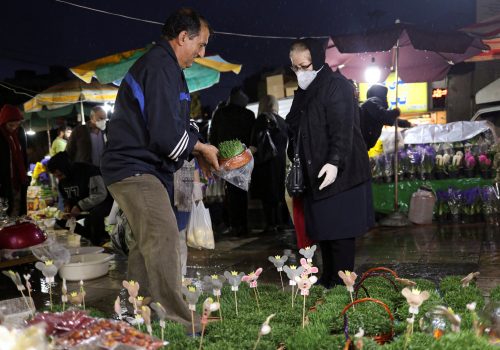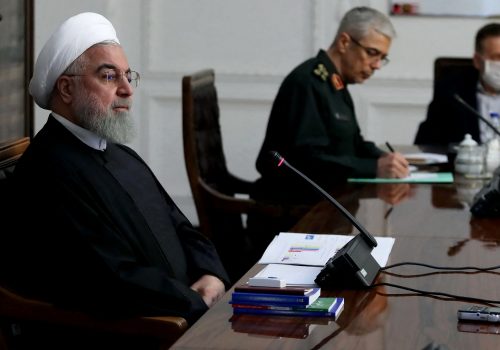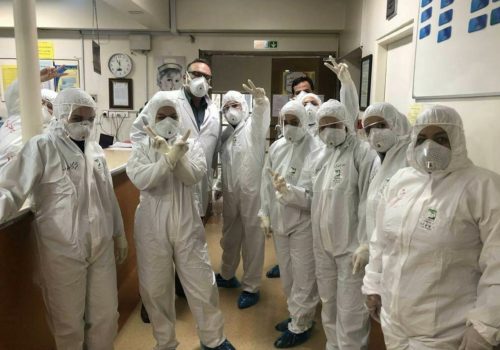March 23, 2020
A loan for Iran and a tragedy of a different kind
COVID-19 is ravaging Iran. It has created pain and suffering. In response, Iran’s healthcare system is stretching thin. Hospitals are running out of supplies, and the country’s economy, battered by sanctions, seems to be unable to provide what is needed to turn the tide of the coronavirus spread. On March 12, Iran requested $5 billion from the International Monetary Fund (IMF) through its Rapid Financing Instrument (RFI), a policy package for the global community to face this latest pandemic. However, the real reasons might be even more alarming: a turbulent oil market and a broken system.
Even without a pandemic, Iran’s economy is experiencing dark days. As a result of US sanctions, Iran’s banking system is isolated; its oil exports have declined to less than 300,000 barrels per day from an average of 2,500,000 barrels per day in April 2018. Still, President Hassan Rouhani’s administration estimated the oil revenues in the next Iranian calendar year, from April 2020 to March 2021, to be $18.25 billion with an average oil price of $50 per barrel. Any observer knows this is not accurate.
First, the Organization of Petroleum Exporting Countries (OPEC) failed to reach an agreement with Russia to cut production to support troubled markets. Russia and other members of OPEC had been following a production agreement since 2017 to support oil prices. The latest disagreement over oil strategy caused oil prices to nosedive. Due to Saudi and Russian oil producers flooding the market, Iran is now caught in the crossfire, losing more revenues than expected.
Second, COVID-19 is causing a slowdown in the global economy. The global demand for energy—mainly crude oil—will be dropping, or compressed at best. Iran, an oil exporter, weakened by sanctions and pressed hard by its rivals, might not be able to export oil to its regular customers, including China. As of now, it is improbable for the Iranian government to materialize the forecasted $18.25 billion for the upcoming Iranian calendar year. The Rouhani administration needs hard currency to keep running what is in practice a welfare state with massive subsidies paid directly to the consumers, and the prices of fuel, electricity, and utilities kept artificially low.
It is not just dropping oil prices, which is frustrating for the Iranian government’s designs. True, the oil market is experiencing a drop in demand and a price war between two major producers, Saudi Arabia and Russia. However, this is not the first time Tehran loses its oil dollars due to Riyadh’s attempt to gain market share. The Iranian economy continues to suffer from structural challenges and widespread corruption. Many would and do argue that the Iranian economy is losing valuable resources and much-needed capital to a broken system. The Iranian government’s continuous interference in the currency exchange market discourages any exporter from bringing home hard-earned revenues in hard currency.
The fact is that Iran has the money; the problem is that it is not inside Iran. Private exporters prefer to keep revenue outside of Iran free of sanctions and the government’s interference. Those who buy Iranian oil cite sanctions and the isolation of Iranian banks. Thus, Iran’s oil revenues accumulate in accounts in China and elsewhere outside the reach of Iranian businesses and the government. According to Farhad Dejpasand, Iran’s minister of economic affairs and finance, the country brought home only $8 billion from total revenue of $40 billion from April 2018 to March 2019. This amount was only 20 percent of the revenues generated by non-oil exports, including petrochemicals. Things improved due to a new system permitting the exporters to exchange their hard currency at rates closer to the market exchange rate. They also can use their revenues to import commodities, which they can sell at market prices. These steps prompted some exporters to complete the cycle of Iran’s foreign trade by bringing the money they had deposited outside Iran.
In February 2020, Abdolnasser Hemmati, the governor of the Central Bank of Iran, told reporters that from April 2019 to February 2020, Iranian exporters brought home $22 billion from their revenues, out of which $7 billion was in the form of imported commodities. It is difficult to measure the performance of Iranian exporters due to inconsistent reporting. However, the Iran Customs Administration reports that from April 2019 to December 2019, Iran exported more than $31 billion, while Tehran’s Chamber of Commerce estimated the total exports are valued at $27 billion. Iranian exporters have brought in 70 percent to 80 percent of their revenues, leaving $5 billion to $8 billion outside Iran’s banking system. At the moment, Iran’s economy needs every penny to respond to the economic impact of COVID-19.
There is no doubt that the global community must find a way to help the Iranian people who have suffered the third-largest number of fatalities and coronavirus cases. However, one wonders how Iran is to receive any amount of money from any financial institution in the world. Even if the United States lifts its sanctions on Iranian banks and the IMF releases $5 billion through RFIs, the Financial Action Task Force (FATF) still has Iranian banks on its blacklist. After parliament failed to approve joining FATF, the case was sent to the Expediency Council, an administrative assembly appointed by the Supreme Leader. The members of the Expediency Council failed to support Iran’s membership in FATF, after months of intense debate. As of now, Iran is a country officially sanctioned and blacklisted. As such, it is implausible to receive any funds via Iranian banks.
One has to ask why the Iranian government does not use the currency exchange market to encourage exporters to bring home all their revenues and why it has failed to reform Iranian banks and to adopt FATF recommendations. Maybe some think it is counterproductive to have these questions answered amid a national crisis. The fact is without proper infrastructures, particularly financial ones, every economic activity would fail to produce the expected results. Crisis management is no exception. It is time for Iranian authorities to dismantle the barriers they have created to interact with the global business community.
Ali Dadpay is an associate professor of finance at the Gupta College of Business at the University of Dallas in Texas. Follow him on Twitter: @adadpay.
Image: An Iranian woman wears a protective face mask as she buys nuts (Reuters)


